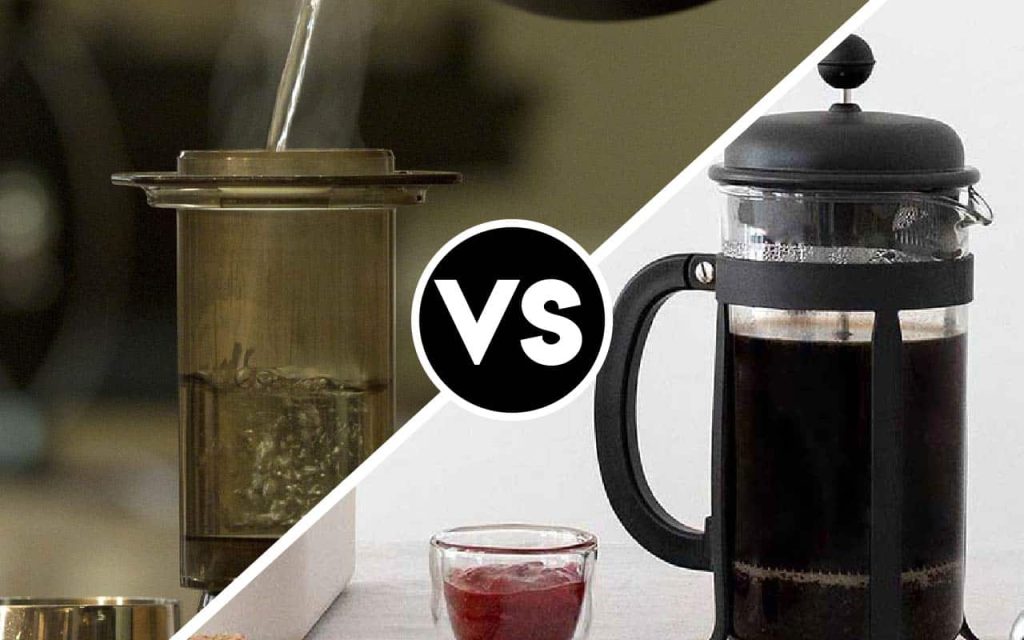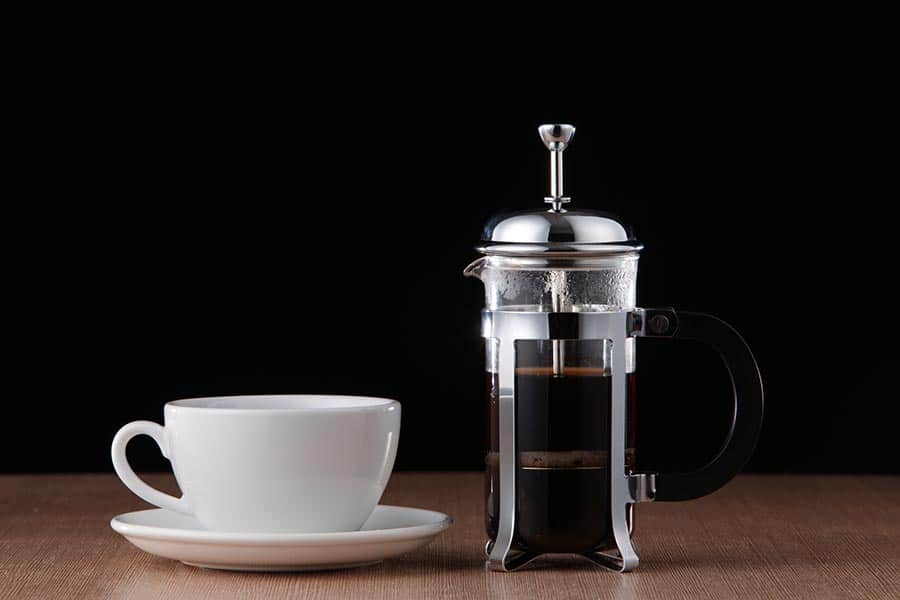Aeropress vs French Press — Which Is Better?

It’s the battle of the presses: Aeropress vs French press.
Of the two manual methods of preparing coffee, which one edges out the other? The French press is not a new innovation. Coffee enthusiasts have been using it to make all kinds of coffee for over 80 years! Even now, the French press continues to dominate the market with a design that remains pretty much the same.
On the other hand, Aeropress is still relatively a newcomer in the coffee-making scene. Unveiled in 2005, it has quickly become a must-have for coffee enthusiasts. In just 16 years, Aeropress has amassed a cult following, and you’ll soon find out why.
This article covers everything you need to know about these two phenomenal coffee-making devices. The honest, head-to-head analysis will help you better understand which of the two devices will suit your needs best.
Strap in, this is going to be a close one! Let’s get started.
Main Differences Between Aeropress vs French Press
The main differences between an Aeropress vs a French press are:
- The Aeropress extracts coffee from beans via immersion and filtration, whereas the French press extracts via a purely immersion method.
- The Aeropress uses a fine paper filter, whereas the French press uses a coarse metal mesh filter.
- The Aeropress makes only one cup of coffee at a time, whereas the French press can make several cups.
- The Aeropress has a brewing time of 1-2 minutes, whereas the French press has a brewing time of 4-5 minutes.
- The Aeropress mostly uses a medium to fine grind, whereas the French press uses a coarse grind.
- The Aeropress is made from durable BPA-free plastics, whereas the French press is constructed from either glass or stainless steel.
When it comes to coffee on the go, nothing beats the Aeropress with its short brew time and portability. However, the French press is the go-to choice if you are in the mood for some full-bodied strong coffee or brewing for friends and family since you can pick one that has a large capacity.
French Press vs Aeropress Overview
There’s no denying that these two devices have a few things in common, but you’ll find that they both have distinct features that set them apart as well.
As you know, the French press has been around for more than a century. In that time, little to no adjustments have been made to the original design. Why? Because everything works just as it should.
Because of that, coffee made using a French press has its own signature taste. Don’t worry, you’ll soon find out why.
While it’s true that the Aeropress is a relative newcomer, this ingenious device has been sending shockwaves through the coffee scene. Since its unveiling in 2005, the Aeropress has experienced a meteoric rise to the top. Not only does it have a simple but effective design, it also has a ridiculously short brew time as well.
Interesting stuff, right? Well, there’s more on the key differences between Aeropress and French press, so read on.
Features Comparison
Filter Type
By default, the French press and Aeropress use different filters. The Aeropress uses a lightweight paper filter, while the French press uses stainless-steel mesh filters. Now, given that you know what you are doing, both coffee makers will produce a rich and satisfying brew. However, you’ll notice slight variations in flavor.
Why? It all comes down to the filters.
French Press

The French press is famous for producing coffee with a heavy, rich and full flavor. The stainless-steel mesh filters are responsible for this. Unlike with paper filters, oils and sediments do make it past stainless-steel mesh filters. These two components are responsible for the distinct taste of French press coffee. While many coffee enthusiasts around the world love the flavor and texture of French press coffee, some do not.
Since grit makes it past the filters, it leads to a messy cup. A good number of coffee enthusiasts do not like this at all. What’s more, the oils make it hard for you to lock down on precise flavor notes of your beans. In all honesty, it comes down to personal preference. The truth is, you should consider the French press if you love your coffee dark and full-bodied.
Aeropress

The Aeropress falls on the opposite end of the spectrum. By default, Aeropress uses a paper filter. Now, while no one is stopping you from using a stainless-steel mesh filter, it’s not advised. The paper filter blocks out oils and sediments from your coffee grounds. For starters, this makes for a brew with a smooth texture and a cleaner taste.
Unlike the French press, you get no sediment in your cup with the Aeropress. In addition, distinguishing the nuanced flavors of your coffee becomes much easier. Since there is little to no oil in your coffee, you will find it smoother compared to the French press. All in all, filters have a huge impact on how your coffee tastes.
In this case, it comes down to preference. For a heavy, rich, and full-bodied cup of coffee, go for the French press. If you want a smooth cup of joe that highlights the distinct flavors of your coffee beans, then the Aeropress is the way to go.
Capacity
How much coffee do you want to brew in one sitting? A small portion for yourself or a substantial amount for friends and family? Answering this will help you purchase the right device. Guess what? If you don’t see yourself brewing large amounts of coffee anytime soon, then the Aeropress will do just fine.
Aeropress
Unlike the French press, the Aeropress is a one-cup brewer.
Making more than one cup at once is not possible with the Aeropress since it doesn’t have a large holding cylinder. What’s more, since the Aeropress holds 7 to 8 ounces, a single serving isn’t a lot of coffee. Now you can get around this by brewing a concentrated cup of coffee and diluting it, but there are obvious limitations.
French Press
This is where the French press shines. First off, you have options when it comes to carafe sizes. Depending on your needs, you can go for the two-, four-, six-, or eight-cup carafe. As you can guess, this makes brewing for your family, friends, or guests much easier.
Now, while you can argue that the Aeropress is faster (we’ll get into this in detail in a moment), this is irrelevant when brewing for a group of people.
For starters, the Aeropress only has a minute or two on the French press. This advantage is lost since you’ll have to clean it out and repeat the brewing process after every single serving. The bottom line is, you should pick the French press if capacity is a concern of yours.
While the Aeropress is great for making a single serving of coffee, it can’t compete with the French press when you are brewing for several people.
Brew Time
The faster you can get your hands on quality coffee, the better. Right? With this in mind, it’s easy to see why the brew time of both coffee makers is a crucial factor. So how do the Aeropress and French press perform? Well, it comes down to two things: pressure and grind size.
Here’s the thing, both the Aeropress and French press are full immersion brewers.
To put it simply, the coffee grounds have to first steep in water before the separation process can be carried out. Here is where it gets interesting.
French Press

Since it uses a steel mesh metal sieve, the French press works best with a coarse grind size.
This is to prevent your grounds from going through the sieve during the separation process. As you can guess, your coarse coffee grounds have to remain in the hot water for longer before full extraction can occur. Now, don’t be quick to discount the French press on this fact alone.
The truth is, you can brew your coffee for a shorter time, but only if you want smooth coffee with subtle flavors. Brewing for a longer period of time (4-5 minutes) produces the full-bodied and aromatic coffee that the French press is famous for.
Aeropress

So what about the Aeropress? While it is a full immersion coffee maker, the Aeropress incorporates pressure in its brewing process. This is why fine grounds are recommended for the best result.
Fine grounds increase pressure in the Aeropress which improves extraction. As a result, brewing with the Aeropress takes only 1-2 minutes at most. Talk about instant coffee!
As you know by now, this speed advantage over the Aeropress only applies when making a single serving of coffee. Because of its larger capacity, the French press blows the Aeropress out of the water if you’re brewing multiple cups of coffee.
To cut it short, the Aeropress is faster than the French press when making a single serving of coffee. But the French press is faster if you are brewing more than one serving of coffee.
Durability and Portability
Before you can splurge on any of these coffee makers, first ask yourself where you will be using the most.
Aeropress
Here’s the thing, the Aeropress is made from durable BPA-free plastic. This makes it ideal for the traveling professional or the rugged outdoors man. Think about it, thanks to its durable materials, the Aeropress won’t break down when exposed to the rigors of travel.
What’s more, the Aeropress is small, making it easy to carry with you. The cool thing is, certain hand grinders can fit in your Aeropress, further increasing its utility and portability.
French Press
On the other hand, the French press is more suited for your kitchen than out on the road. Yes, the stainless steel and borosilicate glass combo is easy on the eyes. But the materials have an average durability index at best.
Couple this with the fact that the French press is rather bulky, bringing it along for your travels is not an ideal scenario. You are better off using it at home where it won’t be subject to the stress of travel.
Bottom line, even stainless-steel French press coffee makers are meant for use at home. For traveling and camping, you are better off using the Aeropress instead.
Versatility
Do you love experimenting with your coffee? Or are you content with a consistent brew with no surprises? Well, if you love switching up your brewing from time to time, then the Aeropress is right up your alley.
Aeropress
Now, there are two major variations you can use when brewing coffee with the Aeropress: the regular method and the inversion method.
With the regular method, the cup is at the bottom of the Aeropress from the start. The inverted method starts with your cup upside down, covering the Aeropress. There’s a lot more to both methods, but they present a range of possibilities.
The regular method produces the smooth, flavorful coffee the Aeropress is famous for while the inverted method allows you to take advantage of the extended steeping period like you would with a French press.
The result? A dark, heavy, and full-bodied brew. What’s more, you can further tweak these methods to produce even more nuanced results.
French Press
On the other hand, the French press has a more rigid set of preparation options. Unlike the Aeropress, your brewing options are limited. The downside is less room for experimentation. The upside is that you get consistent brewing results every time.
Long story short, the Aeropress beats the French press when it comes to versatility.
Aeropress vs French Press: The Winner
I can guess this is the moment you have been waiting for. French press vs Aeropress, which is the superior coffee maker?
Well, it really comes down to personal preference. While this might seem like a cop-out answer, both manual coffee makers represent the peak of brewing engineering. There’s no distinct loser or winner since they both serve their respective uses extremely well.
To recap, the Aeropress is great for quickly brewing coffee when you are traveling. On the other hand, the French press, especially if you have a big one, is more suited to a kitchen setting.
Owen is a writer and editor at Caffe Streets who considers himself a coffee fanatic. He spends his time researching and testing different coffee beans and brewing methods and sharing what he learns with others.





